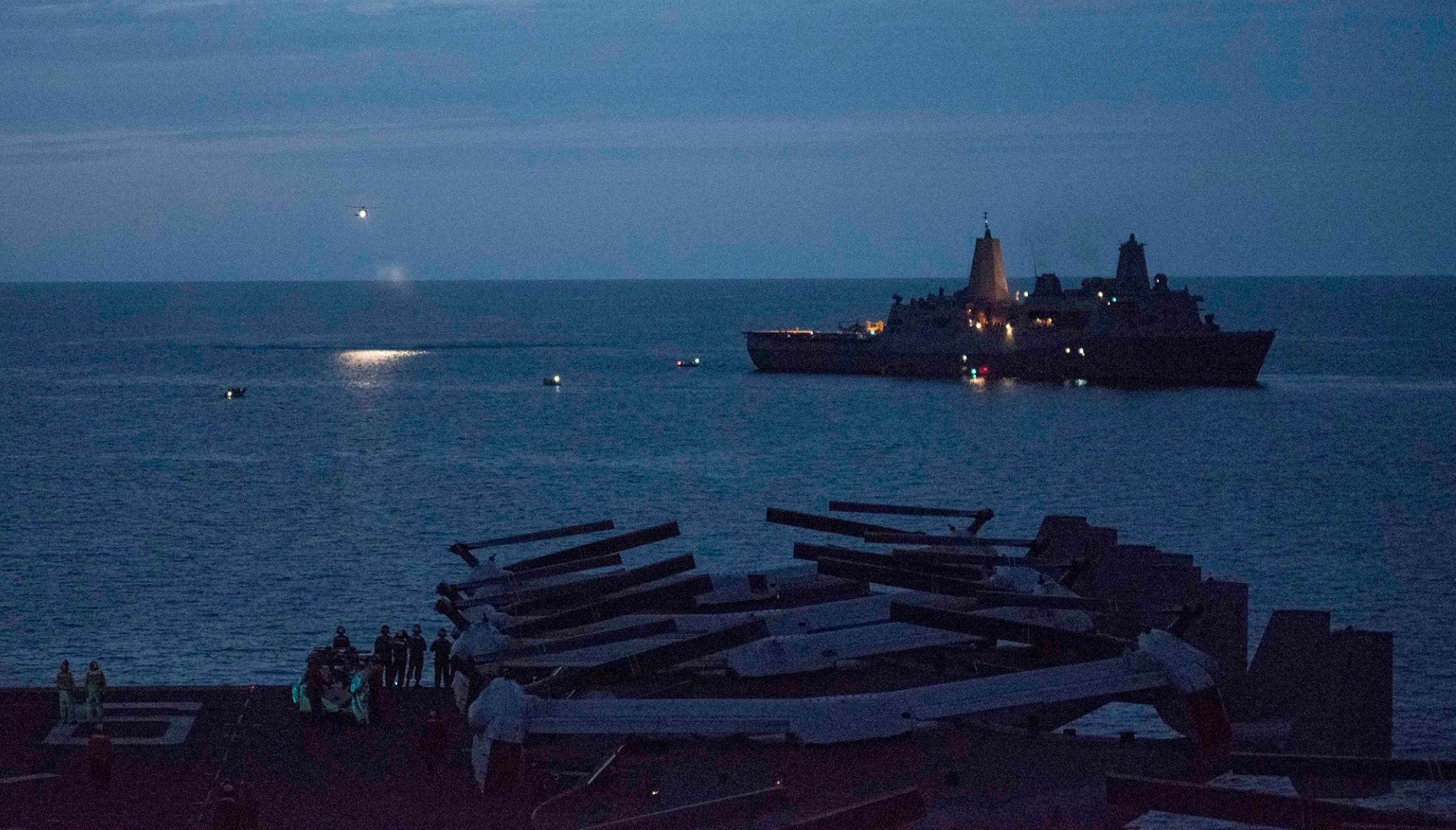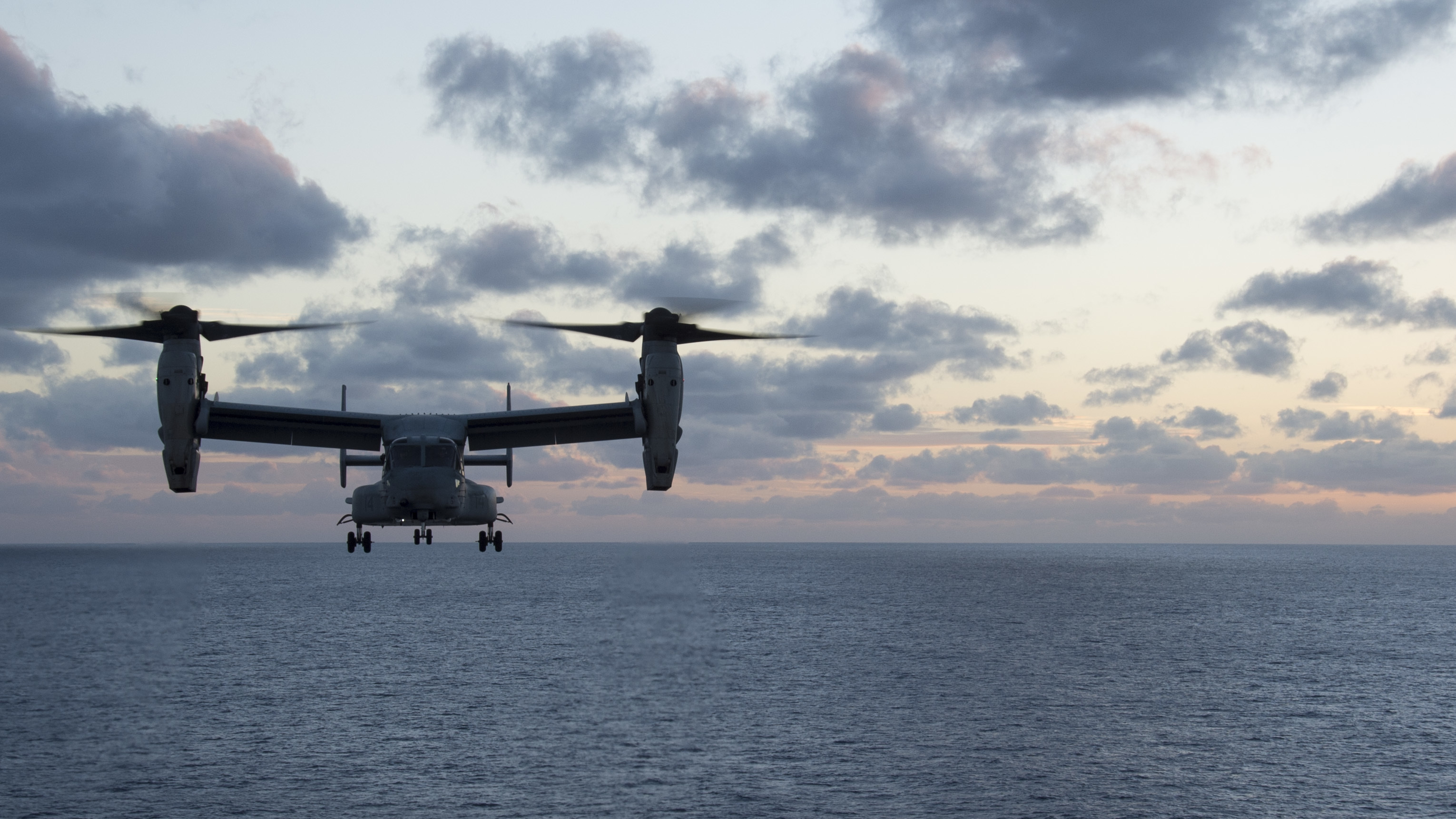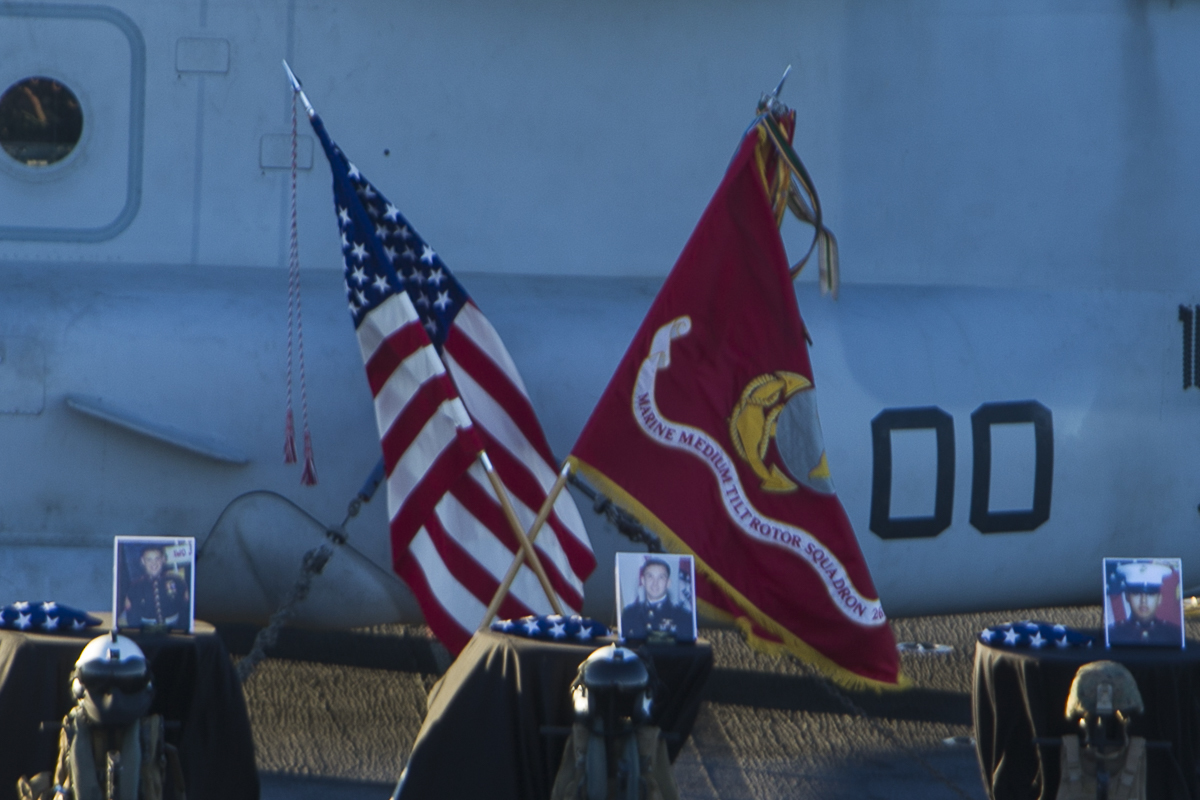
This post has been updated to include additional information about the JAGMAN report that was released.
In December 2015, the Marine Corps saw a near-miss when an MV-22B Osprey landed short of its parking spot on an amphibious transport dock’s flight deck. The aircraft hung halfway off the back of the ship, but the crew and 22 passengers evacuated safely and the aircraft clung to the ship as it returned to port.
In an August 2017 Osprey crash off the coast of Australia, though, the Marines saw the nightmare version of the 2015 scenario: the aircraft, facing similar heavy downwash and dropping short of the flight deck, couldn’t grab on to enough of the ship and fell into the water, killing three and injuring 23.
The Marine Corps recently released the administrative investigation into the Aug. 5, 2017, crash involving an Osprey from Marine Medium Tiltrotor Squadron (VMM) 265 (reinforced) attempting to land on USS Green Bay (LPD-20) off the coast of Queensland, Australia.
The investigation outlines a complex but low-risk mission. The Marine Corps determined the aircraft crashed due to facing too much downwash and not having the thrust to hold its hover, but the aircraft may also have been carrying too much weight, a Defense Department official told USNI News.
Naval Air Systems Command engineers have since looked at the effect of the downwash on a landing aircraft and the amount of power the Osprey needs to overcome that downwash and land safely, and have since made some adjustments regarding how much weight an Osprey may carry on approach to a U.S. ship at sea to ensure it has the power it needs to land, the official said.
The investigation report makes clear that no one was at fault in the incident and that all three personnel died in the line of duty and not due to misconduct.
“The mission was complex, challenging, and included flying into and out of a highly congested operational area. Executing this mission required a detailed plan and superior technical performance. The Marines manning the mishap aircraft were mission capable, fully-trained, and qualified. The mishap aircraft was mechanically sound,” 1st Marine Aircraft Wing Commanding General Maj. Gen. Thomas Weidley wrote in his endorsement of the investigation report.
The report later notes that personnel involved, whose names are all redacted, “were all qualified and medically fit for flight duties. The pilots and aircrew maintained at least eight hours of crew rest the night prior to the mishap and showed no indications of fatigue or stress leading up to the mishap flight,” it reads, and also later notes that the personnel involved were up to date on their certifications and none had ever been involved in previous mishaps. The plane involved was also a newer airframe, with just 203 flight hours and not even old enough to have gone through a major inspection yet.

The Osprey was part of a three-aircraft formation involved in a busy day of a simulated embassy reinforcement, non-combatant evacuation mission, mass casualty drill and logistics movements. On the day of the crash, the mishap Osprey flew from amphibious assault ship USS Bonhomme Richard (LHD-6) to the shore at Raspberry Creek to insert embassy reinforcement personnel, back to the ship to refuel, to nearby USS Ashland (LSD-48) to deliver cargo and a passenger, back to Bonhomme Richard, participated in a mass casualty drill while aboard the ship, delivered mass casualty personnel ashore to Raspberry Creek, returned with other passengers back to Bonhomme Richard, made one more run to Raspberry Creek and back to the big-deck amphib, and then finally made its last trip to Raspberry Creek to pick up non-combatant evacuation personnel before heading to Green Bay, where the fatal mishap occurred.
As the Osprey approached Green Bay, it initially had trouble connecting to the ship’s Tactical Air Navigation signal and so received guidance from the ship’s air traffic controllers. Upon final approach, the Osprey switched its radios to the launch and land frequency. It was set to land in Spot 5 on Green Bay and followed correct procedures to do so, according to the report.
The pilot, whose name is redacted from the report but USNI News understands was a Marine major, “recognized and attempted to correct a 200-300 foot per minute rate of descent with an application of power using the Thrust Control Lever,” the report said of the aircraft’s drop in altitude as it approached the flight deck. The pilot and copilot – 1st Lt. Benjamin Cross, who died in the crash – could not stop the descent and took several actions, including moving the Osprey’s nacelles forward. The left nacelle struck the Green Bay flight deck, and the Osprey moved forward along the starboard side of the flight deck until the plane hit a steel stairway. The left proprotor blades damaged the flight deck and a nearby helicopter, and the impact of the collision crushed the cockpit, breaking the hip and leg of the pilot inside. The aircraft then fell 30 feet into the water, and with a hole in the cockpit, the aircraft filled with water rapidly and sank nose-first.
The report then outlines a 55-minute search and rescue effort, during which time 23 injured passengers and crew were saved by Green Bay, Ashland, Bonhomme Richard and associated crew. Cross, the 26-year-old copilot, never escaped the cockpit. Crew member Cpl. Nathaniel Ordway, 21, was never released from his aircrew endurance vest that tethered him to the aircraft, did not activate his life preserver and did not use his helicopter aircrew breathing device (bottled oxygen). Passenger Pfc. Ruben Velasco, 19, appears to have been properly restrained in his seat in the forward part of the cabin. He appears to have also not used his life preserver or bottled oxygen after the crash. Both drowned in the cabin.

Though all but one passenger made it out of the aircraft after it crashed into the water, the report notes that seven had not attended egress training and two more attended but failed the training. Additionally, eight passengers were not wearing their seatbelts, and the report notes that when the aircraft hit the water the passengers and unsecured gear were propelled towards the front of the cabin, adding to the injuries.
The report notes that “the aircraft commander is responsible for ensuring that all manifested passengers receive an emergency procedures brief. … the Assault Force commander (AFC) has responsibility during tactical troop lifts.” The report notes the unnamed AFC “did not provide an egress brief to the passengers involved in the mishap” and “did not receive training on how to provide an egress brief for aircraft attached to the 31st MEU.”
The defense official told USNI News that the Marine Corps had identified the need to address egress training policy and execution before the Bonhomme Richard Expeditionary Strike Group/31st Marine Expedition Unit deployment in 2017. The service has since looked at the standard operating procedures for which type of personnel are required to pass egress training and which types of personnel may fly without that training. The official said changes have been made since the mishap.
The Navy and Marines have also looked at shipboard procedures and the weight of the aircraft landing on the flight deck. The report’s specific cause of mishap and recommendations were redacted from the publicly available version of the report. The defense official reiterated to USNI News, though, that everyone involved in the mishap followed procedure and technically did everything right according to rules at the time – but according to the report, the way the downwash hit the ship and came back at the aircraft was too great, and the aircraft could not get enough thrust to compensate and get up onto the flight deck.
The report notes that the Osprey took on too much fuel in the morning – about 1,000 pounds too much. To compensate, the Osprey transferred some passengers to another aircraft for the first flight of the morning to even out each plane’s load. However, the Osprey did refuel later in the day, and it had about 8,200 pounds of fuel when the mishap occurred.
Passengers included a combat camera crew from 31st MEU command element and 19 marines and a sailor from Golf Battery, Battalion Landing Team 3/5 Marines. Five aircrew from VMM-265 were also onboard, bringing total personnel to 26. The passengers had gear including personal weapons, riot shields, pelican cases carrying non-lethal force equipment, and one day’s worth of supplies – all of which was accounted for and was calculated at 300 pounds per person.
There appeared to be some confusion regarding the number of personnel onboard, with the aircraft preflight computation noting four crew instead of five, and the aircraft alerting the ship while en route that it had 24 personnel total instead of 26. The preflight computation showed a “useful load of 14,900 pounds,” though it is unclear if that is accurate. It is also unclear if this confusion over total personnel onboard contributed to a miscalculation of weight that had any bearing on the crash.
Following #USMC #Osprey ‘mishap’ on Wednesday, @USSNOLA arrives back at @CoronadoNavy & aircraft craned off pic.twitter.com/JRqbVoHWxx
— Ian Keddie (@IanJKeddie) December 11, 2015
The report notes the similarities between the Green Bay crash and the mishap aboard USS New Orleans (LPD-18) in December 2015. In both cases, the Ospreys were operating at similar gross weights and with similar planned power margins. NAVAIR engineers discovered in data recovered from both incidents “the presence of recirculated downwash reflecting off the hull of the ship and back into the rotor arc,” and in the fatal case of Green Bay the “degree of recirculation was higher due to the further forward assigned landing on Spot 5 of the GREEN BAY, vice Spot 2 in the NEW ORLEANS incident.”
However, in the case of New Orleans, according to media reports, the investigating officer recommended administrative or disciplinary actions because the pilot did not make sufficient attempts to learn how much weight the plane would be carrying, underestimated that weight by about 60 pounds per person, and took on 9,000 pounds of extra fuel more than was needed. No such accusations were levied with the Green Bay crash.
In the Green Bay crash report, engineers note how much thrust would be required for a safe hover and landing, and the Osprey saw a 3.2-percent thrust deficit, which immediately resulted in the descent, which the pilot said in an interview – the transcript of which is included in the report – that he immediately noticed.
“It feels like there is a drop, like a sink. The nose kind of felt like it dipped a touch because it felt like my visibility kind of improved a little bit,” he said of the moment when the Osprey nose began its descent. The pilot recalls Cross and himself noting the need for more power, pushing the thrust control level and nothing happening. “So basically at this point it just kind of kept sinking. … It didn’t feel excessive. It just felt like there was nothing you could do. … At that point, we didn’t feel like we had enough power to continue. I don’t recall seeing anything with the gauges at this point. I just remember being very frightened. … We were hitting the side of the ship. … I am not really sure of the controlling inputs at this point. Because I was just thinking – it was kind of a quick flash of thinking back to the NEW ORLEANS where they had landed on the back, but I think they were able to put enough [of] the plane on the ship where you know they could keep it there and keep it safe where people could get out. That kind of flashed through my mind real quick, but it was like we are nowhere near that. We don’t have hardly any of the plane on the deck of the ship and just remember kind of moving to the right. The plane moving to the right, moving to the right.”





